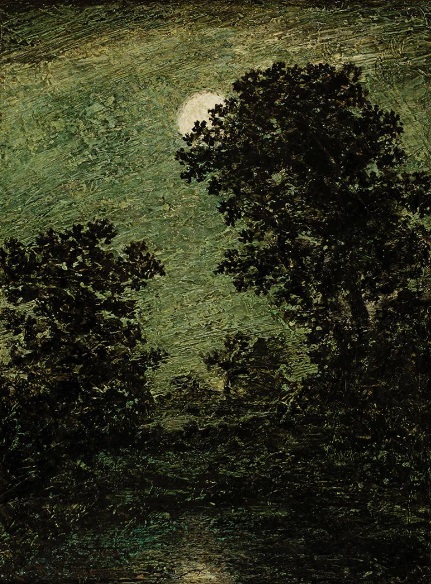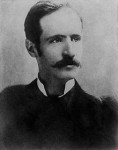
Ralph Albert Blakelock
American, 1847-1919
Silent Night, 1889
oil on wood panel
10 x 7 3/8 in.
SBMA, Gift of Mrs. Alfred B. Clark
1962.37

Photo of Blakelock dated 1870.
RESEARCH PAPER
At first glance some viewers might find this landscape tranquil and inviting, while others may find it haunting, possibly eerie. A full, bright moon silhouettes trees on either side of a placid stream that reflects the moon’s light. The foreground is dark and obscure. One cannot discern the stream’s banks from its adjoining terrain. Shadowy trees with feather-like black leaves dominate the space on either side of the stream, behind which one sees additional silhouetted trees arranged on a countryside that is nearly as ill-defined as the work’s foreground. The moonlit sky seems to vibrate. The piece simultaneously evokes feelings of stillness and agitation.
In 1891, two years after Ralph Albert Blakelock painted this imaginary landscape, he suffered his first “mental breakdown.” Eight years later, in 1899, he was diagnosed with, and institutionalized for, paranoid schizophrenia. He would remain hospitalized almost continuously until his death in 1919.
Born in New York City, Blakelock was a self-taught painter. His early landscapes follow the style of the Hudson River School of painters, known for their realistic portrayals of nature. He later developed a more intimate and subjective painting style. His later techniques were heavily influenced by both the French Barbizon School, whose painters favored the depiction of dark forest scenes on heavily worked surfaces, and Tonalism, an American off-shoot of the school which emphasized mood, shadow, and scenes with darkly colored skies and mists using muted grays, browns, blues, and greens.
Blakelock would often work on paintings for years, building multiple layers of paint and varnish and then scoring, scraping, or rubbing them away. This is most apparent in the deep textures found in the work’s sky. Streaks of differing lengths and paint thicknesses collectively tilt slightly downward from the piece’s upper right corner to its lower left corner. The streaks are made up of a myriad of hues predominantly made up of light greens and beiges. The brush strokes and scraping create a moiré pattern very unlike the smooth, black night skies that we are accustomed to seeing. Although fluid, the sky’s texture and pattern somehow seem erratic.
The slight downward diagonal created by the sky is reinforced by the higher tree line and slope of the stream’s right bank in comparison to the lower elevation and tree height along its left side. The viewer’s head tends to bend slightly to the left; however, overall balance is created by the sky’s bright moon and its corresponding reflection at the base of the stream, both of which lie nearly center in the piece. The dark trees flanking either side of the stream, coupled with the trees found farther back, likewise center our attention. The symmetric balance creates feelings of quiet and calm.
The trees’ dark leaves sharply contrast with the sky; their edges have been meticulously delineated and deftly dappled with the moon’s shimmering silver light. The same level of detail is found in the stream where one can almost see the movement of the water’s subtle ripples. This specificity contradicts the viewer’s inability to clearly discern the stream’s edges or any features of the landscape’s middle- and backgrounds. The sky’s unsettling impasto contradicts the piece’s balance. Perhaps this incongruity reflects Blakelock’s mounting mental instability.
Blakelock’s recognition as a painter nearly paralleled his first hospitalization. It was during this period that he began to focus almost exclusively on his moonlight scenes. Ultimately, the popularity of these “moonscapes” in the United States skyrocketed, and their market values correspondingly soared. By 1916 his work titled “Brook by Moonlight” sold at auction for the largest dollar amount ever paid for a living American artist. By the time of his death three years later, he had become one of the most forged artists in the country. He would maintain that status, posthumously, for decades.
Blakelock’s fame as an artist flourished during his lifetime. In 1916, the same year that his works began to fetch unprecedented prices, he was also elected to full membership at the National Academy of Design. Despite these successes he consistently failed at business and financial transactions. His mental instability exacerbated these incompetencies and, for the majority of his adult life he, along with his wife and their nine children, lived in extreme poverty.
Prepared for the Santa Barbara Museum of Art Docent Council by Sue Walker, 2024.
BIBLIOGRAPHY
Anonymous. “Ralph Albert Blakelock (1847-1919).” White Mountain Art & Artists.
https://www.whitemountainart.com/about-3/artists/ralph-albert-blakelock-1847-1919/.
Anonymous. Ralph Albert Blakelock, Wikipedia.
https://en.wikipedia.org/wiki/Ralph_Albert_Blakelock.
Anonymous. “Barbizon School.”
https://en.wikipedia.org/wiki/Barbizon_School
Anonymous. Hudson River School, Wikipedia.
https://en.wikipedia.org/wiki/Hudson_River_School
Cleveland, David. “The Twelve Characteristics of Tonalism.” American Tonalist Society.
https://www.americantonalistsociety.com/what-is-tonalism
Luhrs, Kathleen, Editor and Burke, Doreen. “American Paintings in the Metropolitan Museum of Art, Volume III, A Catalogue of Works by Artists Born between 1846 and 1864.” New York: Metropolitan Museum of Art, 1980.
https://www.metmuseum.org/art/metpublications/American_Paintings_in_The_Metropolitan_Museum_of_Art_Vol_3_A_Catalogue_of_Works_by_Artists_Born_be
Mitchell, Mark. “Blakelock in the Eyes of Artists.” In “Ralph Albert Blakelock, The Great Mad Genius Returns,” edited by Eugenia Bell, pp.2-7. New York: Meridian Printing for Questroyal Fine Art, LLC, 2016.
https://www.questroyalfineart.com/wp-content/uploads/GMGcat-1.pdf
Platt, Myra. “Start with What You See.” In “Ralph Albert Blakelock, The Great Mad Genius Returns,” edited by Eugenia Bell, pp.8-9. New York: Meridian Printing for Questroyal Fine Art, LLC, 2016.
https://www.questroyalfineart.com/wp-content/uploads/GMGcat-1.pdf
Sangimino, Nina. “Ralph Albert Blakelock (1847–1919), The Life of the Artist.” In “Ralph Albert Blakelock, The Great Mad Genius Returns,” edited by Eugenia Bell, pp.10-14. New York: Meridian Printing for Questroyal Fine Art, LLC, 2016.
https://www.questroyalfineart.com/wp-content/uploads/GMGcat-1.pdf
SBMA CURATORIAL LABELS
The tragic story of Blakelock’s ill-fated career reads like a dramatic novel. Diagnosed with paranoid schizophrenia in 1899, he spent the next two decades of his life in the New York State Hospital for the Insane. Ironically, his moonscapes – typified by a dark moody palette with pigment thickly applied as seen here – suddenly began to mount in popularity. Confined because of his mental illness, Blakelock and his family never reaped any financial reward from his celebrity.
- Preston Morton Reinstallation, 2022
